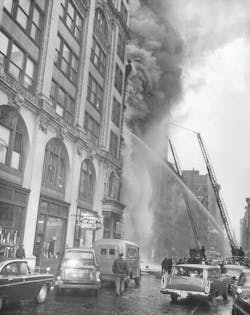COLON, PANAMA: JUNE 3, 1913 – A morning fire swept through an entire block of frame buildings. The Panama Fire Department rushed engines to the scene on a special train and assisted in extinguishing the conflagration.
NEW YORK CITY: JUNE 14, 1913 – About 1,000 barrels of gasoline stored in a yard adjacent to a stable at 507 Water St. in lower Manhattan caught fire at about 10 P.M. Trucks, wagons and horses were also stored in yards that backed up to the East River. When the fire appeared in a shed, the watchman hurried to lead the stabled horses to safety. Moments later, the flames reached a shack housing the stored flammables, which blew up and flooded the street with burning gasoline. Lieutenant Harry Schoener of Engine 15 was caught amid the flaming gas. Trying to escape, he fell directly into the burning gasoline and was completely engulfed in flame. Captain Patrick Walsh of Engine 7, with the aid of Engineer of Steamer William McAllister, pulled the lieutenant from the flames and carried him to safety. Both men were later awarded medals for their bravery. Three alarms were transmitted and several fireboats were used. Police Commissioner Rhinelander Waldo, the city’s former fire commissioner, arrived to watch the fire and was nearly killed when a hose burst, knocking him flat and drenching him with water.
FERNDALE, NY: JUNE 16, 1913 – The entire business section of this town, located three miles south of Liberty, was wiped out by a fire after a child accidently knocked over an oil stove in a meat market. The store was quickly filled with flames that extended and tore through building after building, including the post office. Firemen were hard pressed to gain the upper hand. Two children were missing and presumed dead in the smoldering rubble. Fire companies from Hurleyville, Liberty and Monticello assisted in the battle.
NEW YORK CITY: JUNE 24, 1913 – Firemen were dragging hoses into position on the fourth floor of a burning 10-story loft building at 121 17th St. in Manhattan when smoke conditions became untenable. Several men tried to crawl through the dense smoke to the front of the building to vent the fourth-floor windows, but were overcome and dragged back to the rear windows. Seeing their difficult position, Fireman Frank Costello grabbed a hook, went to the third floor below and climbed out onto the window ledge. His attempts to break the glass fell short, so Costello asked the two firemen holding him steady to lift him up as high as they could. The two men leaned as far out the window as they could and with trembling arms raised him high enough to break out the windows above. Costello dove back into the third floor as a shower of broken glass just missed him. On the fire floor, conditions quickly improved and the attack was begun.
BUFFALO, NY: JUNE 24, 1913 – An explosion devastated a grain elevator, killing at least 17 men and injuring 60 more. The elevator, located at the Husted Milling and Elevating Co. at Elk and Peabody streets, was left in flames after the dust explosion. The engineer of a passing train was killed by the blast that shattered windows, injuring many passengers. A dozen boxcars loaded with grain were also destroyed. Every ambulance in the city responded, but there were so many injuries that the flatbed section of the damaged train was used to transport many of the wounded grain elevator workers. Firemen poured tons of water on the volatile remains all day and into the night, hoping to cool things enough to allow a complete search. Losses were estimated at a half-million dollars.
BATAVIA, NY: JUNE 26, 1913 – Three employees of the Batavia Preserving Co. were eating dinner outside the Mill Street plant in the late afternoon when they saw flames pouring from the plant’s powerhouse. The factory canned and stored peas, beans, spinach and other crops and was built alongside Tonawanda Creek. The fire department was called, but found the entire plant a mass of flames as they rolled in. Billowing clouds of smoke chugged from the building as hundreds of cans inside the blazing structure exploded. Firemen worked all afternoon and into the evening to bring the blaze under control. Within the ruins were a half-million canned vegetables, fish and puddings. The fire was declared out the next morning. The company immediately took steps to stay in business. Temporary structures were built and two weeks later, the first farm delivery was made. The plant was up and running and the local crop was saved.
ATHENIA, NJ: JUNE 28, 1913 – An unusual accident occurred when a large touring car containing four people and traveling at a high speed went out of control and crashed into a home on Van Houton Avenue. The gasoline tanks at the rear of the car were damaged and the home’s gas lamps quickly ignited the leaking fluids. The blaze spread rapidly from the front porch as the car’s occupants tried to extinguish the blaze with sand and dirt. Above, the sleeping occupants were jolted from their sleep to find their home in flames. They all escaped without injury. The Athenia Volunteer Fire Department arrived quickly and soon had the fire under control.






